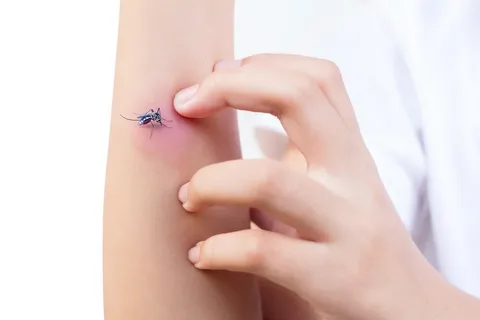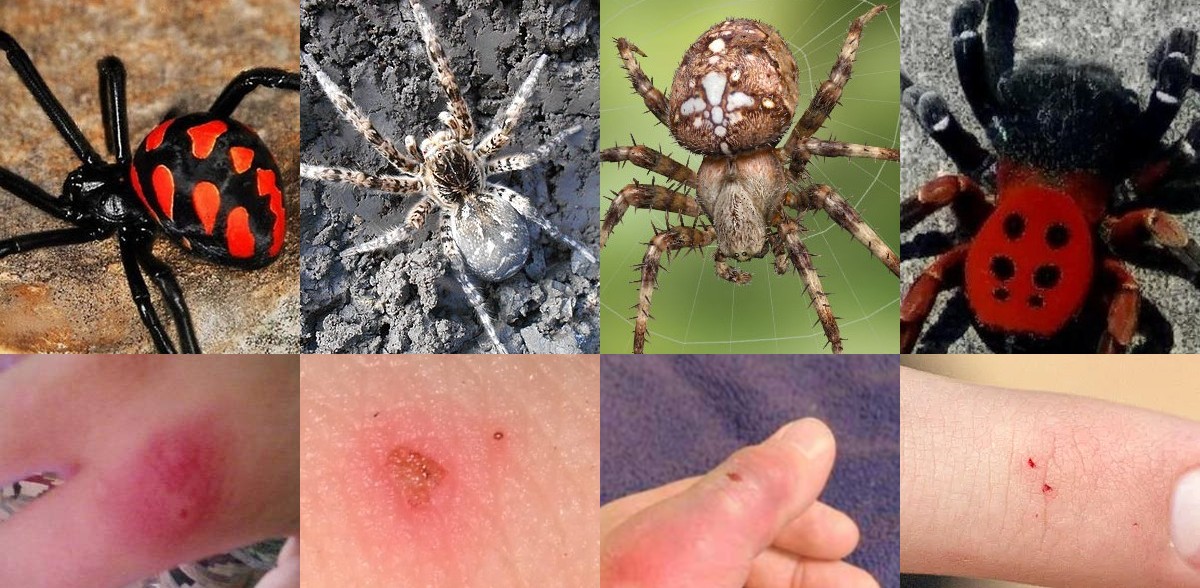Summer is the perfect time for outdoor recreation. But spoiling all the charm of a picnic can be insects, which appear in countless numbers with the first warm days. The bloodsucking species that bite humans and animals are particularly active. They “attack” in the home and on the street, leaving behind at least a feeling of discomfort, pain and itching, and, in the worst case, causing a serious allergic reaction or infection with infectious diseases through their bites.
There are many types of blood-sucking insects, and a person doesn’t always have time to see who is attacking them. It is therefore worth knowing the main differences between the different bites: appearance, symptoms, possible consequences.
How to figure out who bit you
A blood-sucking insect can be “encountered” not only outdoors, but even at home. The location where the bite occurred also helps in determining its species. For example, bed bugs live only in the house, and ticks live in the forest, park, field, where the grass is high. Although it is possible for these insects to bite outside of their habitat.
To figure out who caused the bite, it’s worth paying attention to the basic signs. They are different for each bug or gnat.
Mosquitoes
Mosquitoes are also called vampire insects. And they deserve the name because they bite more often at night or at dusk. They can attack outdoors, especially near bodies of water, or at home, entering a room through open windows and doors.
A mosquito bite looks like a red blister under the skin. It is shaped like a circle or a blob with a small bite mark in the middle. Such a papule is very itchy, and if you start scratching it, the itching will increase due to the mosquito saliva getting into the surrounding tissues. After a certain time, the blister disappears, but for some people, especially children, redness, itching and swelling in the place of the bite remain for several days.
In general, mosquito bites are not dangerous. But you should consider that there are about 300 species of mosquitoes, and some of them are carriers of serious diseases: malaria, tularemia, yellow fever. In our regions it is difficult to meet them, so the information is relevant, rather, for the traveler.
Gnats
Gnats are called several groups of insects, united by one property: their small size. Most of them are neutral to humans and do not pose any threat, but there are also blood-sucking species. Gnats that can bite resemble flies in appearance, but they are several times smaller. The body length of such insects is 2-4 mm. They have two wings, three pairs of legs and a stabbing-sucking mouthpiece.
Gnats inhabit almost all climatic conditions, but the symptomatology and appearance of the bite are almost identical. The wound site, depending on the presence or absence of a blood-sucking proboscis (as in mosquitoes), may be in the form of:
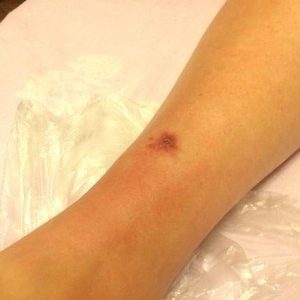
- dark maroon spot of small size – from insects with a trunk;
- red abrasion of small diameter with jagged edges – a bite left by midges without a proboscis, because they simply tear off a piece of tissue.
Blood may run from the puncture site of the skin when bitten for some time, because the saliva of the gnats has an ingredient that prevents it from clotting. There is no itching, but there is a burning sensation and throbbing pain. Depending on the individual person’s reaction to the bite, swelling and hardening of tissue, redness or thickening may occur. In places with thin skin, all symptoms are more noticeable. On average, it takes one week for the skin to fully regenerate. But if the bite is scratched, it can take as long as a month.
Some people may also have an allergic reaction to the bite of a gnat. Its main symptoms, in addition to those described above: tearfulness of the eyes, swelling of the mucous membranes, the appearance of red spots on the skin, but not in the place of the bite.
Ants
Ants are considered one of the most industrious insects. There are about six thousand species in this family, but only a few of them are potentially dangerous in terms of a possible bite. As you know, such insects do not attack first, but only when they need to defend themselves. That is why it is better to bypass ant hills and not crush an ant on your body, but try to shake it off easily.
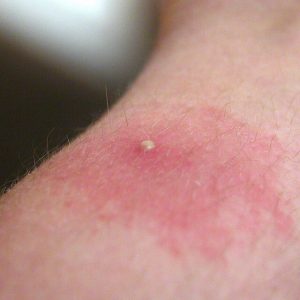
If the insect does bite, it is fairly easy to identify. A small red spot and slight swelling appear at the site of the bite. There is also a strong burning sensation, which is explained by the formic acid getting into the wound. In particularly sensitive people, the symptoms are more pronounced:
- In addition to the red spot, a large pink spot appears around it.
- The swelling is severe.
- The site of the lesion may “burn.”
- The itching and burning is unbearable.
Unpleasant sensations in the absence of hypersensitivity pass in a couple of hours, and the place of the bite itself can still itch for 1-2 days. If a person has an allergy or had to survive an attack by a large number of insects, he can feel a strong dizziness, headache, decreased blood pressure, difficulty breathing, increased temperature, swelling of the larynx. In such cases, you should immediately seek medical help.
It is also important to know that the biggest biteer is the large woodland ant. Second in the ranking is the red ant, whose bites are very painful. Somewhat weaker are the symptoms if the red ant attacked. And the “safest” is their black relative.
Ticks
Ticks are typical representatives of blood-sucking insects. The most dangerous of them belong to the family Ixodidae. They attack the victim sitting in the grass, branches of bushes, and sometimes from the ground. However, the bite is not as terrible as the prospect of contracting encephalitis, tularemia, Lyme disease, rickettsiosis, because these insects can contain in their secretes pathogens of such diseases.
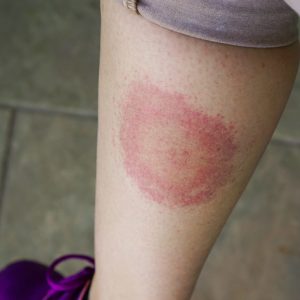
Finding a tick on the body is quite easy. Especially as the bloodsucker gets fatter and more visible as it becomes saturated. Such an insect looks for places on the body with thin skin to cut through it more easily with its proboscis.
“Favorite” places for ticks to suck on:
- groin area;
- lower back;
- armpits;
- Areas on the neck and behind the ears.
Sometimes the bite can be noticed after the tick has fallen off. It looks like a small red rounded spot on the surface of the skin. Rarely, it is oval in shape and has uneven edges. It does not hurt, but it itches, there is a slight swelling, there may be a slight rash. Allergy sufferers, children and people with high sensitivity have stronger symptoms. Rarely, there is a fairly severe allergic reaction with Quincke’s edema, respiratory arrest, paralysis.
Not every tick is a carrier of the disease, but seeking medical attention is a must.
If the insect remains on the skin, it is better not to remove it yourself, but to contact specialists. And even a tick removed by yourself in a sealed jar should be taken to a laboratory, because the diseases they carry are quite serious:
- Tick-borne encephalitis – can be fatal.
- Lyme disease – if not diagnosed in a timely manner, disability or death is possible.
- Ehrlichiosis – the disease causes respiratory and renal failure.
- Anaplasmosis – affects the hematopoietic system.
- Typhus typhus – there is a rash on the body and enlarged lymph nodes.
- Tularemia – characterized by involvement of lymph nodes, mucous membranes of the eyes and pharynx.
Fleas
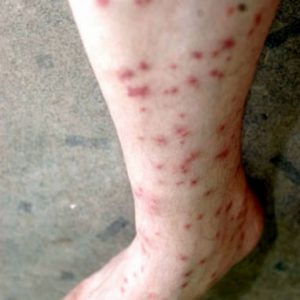
Annoying and dangerous because they can be a carrier of serious infections: anthrax, plague, tularemia, brucellosis, typhus, pseudotuberculosis. This is all about fleas, which prefer to parasitize on cats and dogs.
Such insects will not get on the human body, because they need heat and moisture from animal hair for comfort. However, they also pose a danger to human health.
Identifying flea bites is fairly easy. There are several signs:
- A small number of small red spots appear on the skin, following one another in sequence;
- The redness is very itchy, because there are irritants in the flea’s saliva;
- The bites are located mainly on the lower extremities, since the distinctive feature of fleas is to move by jumping.
And these are the mildest symptoms.
In some cases, the saliva of the insect can lead to the development of an inflammatory process, swelling of the lesion sites, the appearance of scabies. But the most dangerous are infectious diseases, so to prevent flea bites, you need to rid pets of such parasites in a timely manner .
Fleas
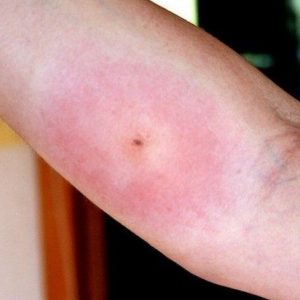
Blindflies are the largest blood-sucking insects. Interestingly, they bite exclusively females that can suck up to 200 mg of blood at a time. A single bite is not dangerous, but a mass attack of gadflies due to the toxicity of their saliva can cause changes in physiological blood parameters and the appearance of local inflammatory processes.
You can meet the gadfly in the forest, in the steppe zone, in the taiga, as well as near water bodies.
The bite of this insect has characteristic symptoms: redness around the wound, a burning sensation and pain. The intense itching is particularly unpleasant, in comparison with the mosquito it is much stronger. After 6-8 hours, the symptoms may intensify, and on the second day they reach their peak.
A person with a weakened immune system, chronic diseases, and hypersensitivity may also develop erythema at the bite site, 7-8 cm in diameter, and enlarged lymph nodes.
In some cases a severe allergic reaction is possible: Quincke’s edema, anaphylactic shock .
Spiders
There are several thousand species of spiders on the globe. Many of them pose a danger to humans because of their venomous nature. But there are also such representatives of these insects, the bite of which causes only a hypersensitivity reaction.
In our latitudes there are several species that can bite humans:
- Caracourt. An adult has a pure black coloration, while a young one has bright red spots on its abdomen, sometimes in the form of an hourglass. There is redness and swelling at the site of the bite, and a burning pain is felt throughout the body. Headache, palpitations, muscle cramps, and heaviness in the chest may occur.
- Tarantula. The bite of this spider is very painful. It is followed by sudden dizziness, numbness of limbs, drop in blood pressure, disruption of heart rhythm.
- Crossbones is a relatively safe of insects, because after its bite there is only a slight weakness and redness in the affected area.
- Black Thickheaded Spider. The site after the bite of this spider loses sensitivity for up to several days, a strong pain is felt.
Wasps, bees, hornets, bumblebees
All of these striped insects are rarely the first to attack humans. But they can become aggressive when exposed to cigarette smoke or the use of cosmetics with a strong odor. In terms of sensation, wasp, bee, hornet and bumblebee stings are about the same. Redness and swelling occur at the site of the lesion, which go away within 1-5 days, in the face area – up to 8 days. Painful sensations are quite strong. If a person is hypersensitive, allergic reactions and unpleasant health-threatening symptoms are possible:
- Quincke’s edema, anaphylactic shock;
- Rash all over the body;
- shortness of breath;
- convulsions with loss of consciousness;
- weakness, dizziness;
- nausea, vomiting.
When a bee stings, it is important to pull out the sting, because the venom from it will continue to enter the bloodstream and cause dangerous symptoms .
Flies
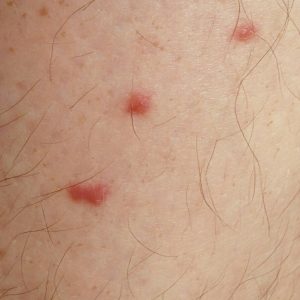
Flies are considered the most annoying insects. They are willing to explore every corner of the house, landing on food and furnishings. Particularly annoying is the unpleasant buzzing of their wings. But some species are not just disturbing the silence, but also quite insidious, because they can bite. Most bloodsucking flies are found throughout Europe and Asia:
- Black-spotted flies with black spots on the abdomen: their bite has the appearance of red rashes with small maroon bumps. Pain and itching are present. Favorite sites for insect infestations are the ankles, feet, under the knees, and often the entire leg.
- Sand flies are small in size with shaggy wings, shade of gray-brown. They prefer to attack at dusk, biting very painfully. There are itchy, burning bumps and blisters of red at the site of the bite. But these are the mildest symptoms. The danger of sand fly bites is that they are carriers of leishmaniasis, which results in sores on the body.
- The tsetse fly, fortunately for us, lives in African forests. Its bites cause red bumps and sores on the skin. It can also cause sleeping sickness.
- Deer flies are distinguished from their congeners by their bright green or golden eyes. They are very active in the spring. Their habitat is bogs, lakes, reservoirs. Deer fly bite looks like a red bump and rumen. A person feels a lot of pain. The most dangerous thing is that such insects carry tularemia, which without treatment can end in death.
Scorpion.
Poisonous scolopendras or, as they are called, millipedes used to inhabit Africa, the South of America and Europe. Because of climate change, they can now be seen in other regions as well. This arthropod insect is 10-15 and sometimes even 30 cm long. It is able to crawl into any crevice, so it can be found even in private houses.
The scolopendra has 42-46 pairs of legs, each with a poisonous gland. Contact with human skin results in burns and allergic reactions. And its bite is particularly painful – 20 times stronger than that of a bee. Bitten by a scolopendra feels an intolerable headache, shortness of breath, trembling hands, and his body temperature can rise to 39 degrees. There is redness and swelling at the site of the bite, and traces of punctured skin may be visible. Sometimes scratches from the legs of a scolopendra are visible.
The scorpion is another representative of arthropod insects. Some species are very poisonous. It is important to identify its bite in order to provide timely first aid and save human life.
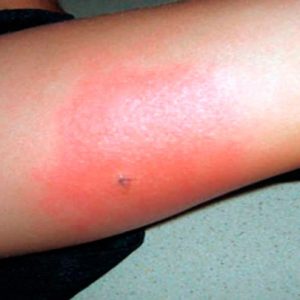
You can tell if a scorpion has bitten you by several signs:
- The onset of a sharp burning pain. Its intensity depends on the venomous nature of the scorpion. The painful sensation may subside or intensify.
- Reddening of the area around the sting site and a black dot in the middle.
- Rapidly increasing swelling.
- Severe itching sensation.
- Numbness of the affected area.
- Formation of blisters filled with a clear fluid inside.
In addition, a person bitten by a scorpion feels dizziness, nausea, headache, tachycardia, restlessness, and abdominal pain. When the most venomous species are bitten, there may be enlarged lymph nodes, active salivation, swollen tongue, and pus from the eyes.
How to protect yourself from a bite
In most cases, you can avoid being bitten by an insect, thereby protecting your health and life, because many of them carry dangerous diseases.
To do this, it is worth following a few rules:
- Do not walk through bushes and tall grass;
- not to use strong perfumes, brightly colored clothes in summer;
- wear socks and long pants, and preferably rubber boots, when going to the woods or going to walk in an uncultivated field;
- avoid bodies of water with standing water;
- Apply special sprays to exposed areas of the body, and wear clothing with long sleeves in the evening to reduce the area of access to the skin.
Sources:
- Bites and stings: Insects. (n.d.).
hopkinsmedicine.org/healthlibrary/conditions/pediatrics/bites_and_stings_insects_85,P01032 - Insect bites and stings. (2008).
dermnetnz.org/cme/arthropods/insect-bites-and-stings/ - Mayo Clinic Staff. (2018). Insect bites and stings: First aid.
mayoclinic.org/first-aid/first-aid-insect-bites/basics/art-20056593 - McKeown N, et al. (2014). Verified spider bites in Oregon (USA) with the intent to assess hobo spider venom toxicity. DOI:
10.1016/j.toxicon.2014.03.009 - Polis GA. (1990). The biology of scorpions.
worldcat.org/title/biology-of-scorpions/oclc/18991506 - Shirai O, et al. (2002). Alcohol ingestion stimulates mosquito attraction.
pubmed.ncbi.nlm.nih.gov/12083361/ - Verhulst NO, et al. (2011). Composition of human skin microbiota affects attractiveness to malaria mosquitoes. DOI:
10.1371/journal.pone.0028991
Read also:
- How do I check my gastrointestinal function?Stomach pain, constipation or diarrhea, bloating, belching, heartburn? These are all symptoms of problems in the gastrointestinal tract. It starts with the mouth and esophagus and ends with the intestines and rectum.
- What are the benefits of hazelnut oil for the skin?Hazelnut oil is rich in vitamins and essential fatty acids that nourish the skin. Here are a few reasons why you should add this oil to your skin care routine.
- Immune-boosting aromatic oilsThere are many products and treatments that can help your body to build a natural resistance to the harsh winter months, and aromatherapy is one of them. There are many studies supporting the healing power of aromatherapy and it is good for both mental and physical health. Aromatic essential oils also have many health benefits… Read more: Immune-boosting aromatic oils
- Marula Oil Benefits, Uses, and PrecautionsMarula Oil is an exotic oil that comes from the African Marula tree. It’s a good ingredient for skin, hair, and nails. Learn more about the benefits and precautions of Marula Oil with our guide.
- Goal setting for students, children and young peopleRemember when you learned how to set goals? If you have trouble answering this question, you are not alone! Most of us don’t spend much time thinking about how we set our goals. In fact, many of us don’t even think of goal setting as a skill; rather, it’s something we do without much thought.… Read more: Goal setting for students, children and young people
The articles on this site are for information purposes only. The site administrators are not responsible for attempting to apply any recipe, advice or diet, nor do they guarantee that the information provided will help or harm you personally. Be cautious and always consult a doctor or nutritionist!
*All products recommended are selected by our editorial team. Some of our articles include affiliate links. If you buy something through one of these links, you help us earn a small commission from the seller and thus support the writing of useful and quality articles.


